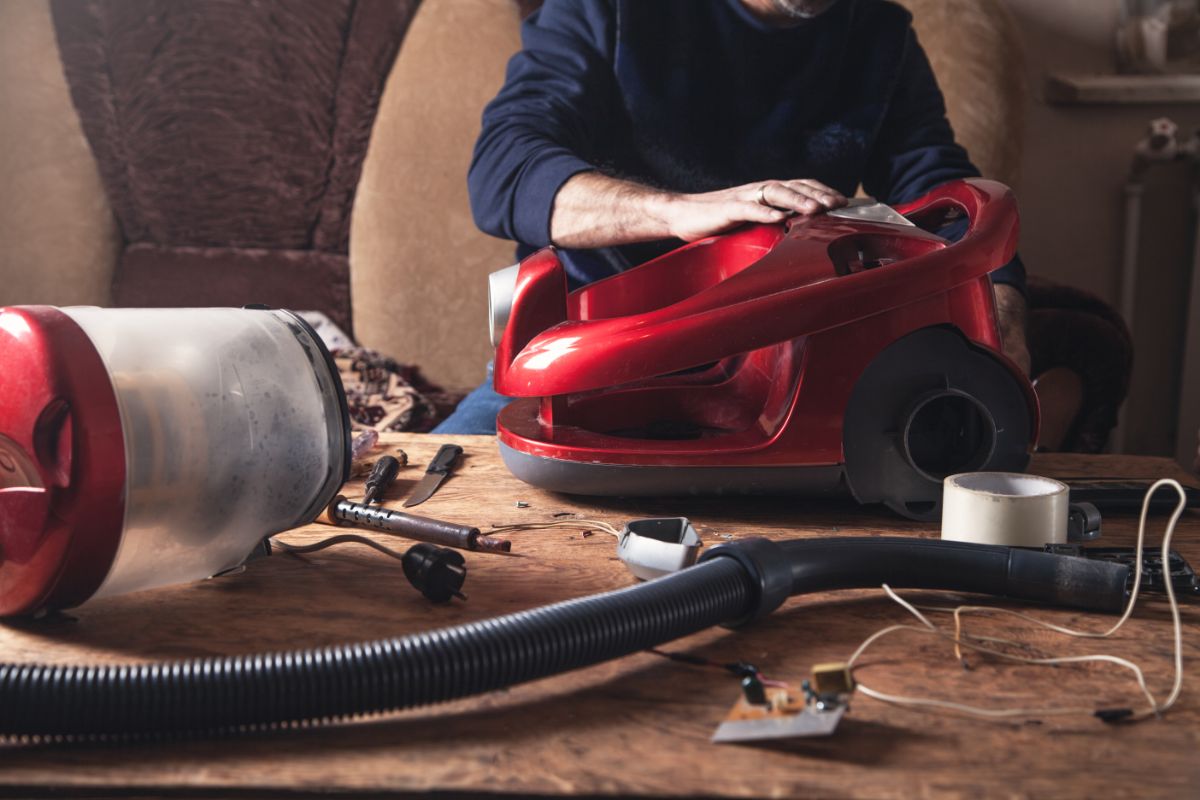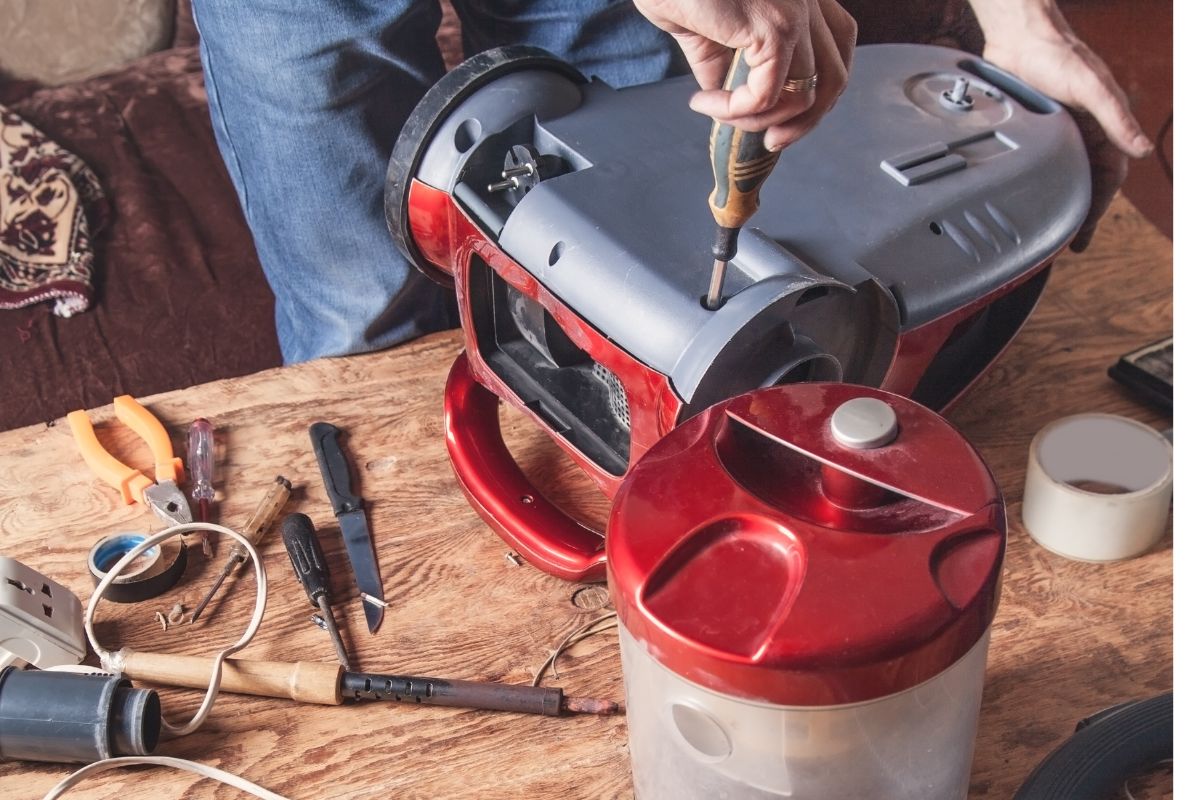What is a beater bar? What is its purpose on a vacuum cleaner? Let’s talk about that.
The vacuum cleaner is a tool we use to clean the house, and many of us don’t think any more about it. But when you need to replace your vacuum, or you’ve noticed it isn’t performing at its best, then there’s suddenly some terminology you have to learn.
One such term is beater bar.
The beater bar is a rotating bar inside the vacuum head which agitates and loosens dirt. Although it seems simple, the beater bar has a complex role in the vacuum cleaner, and it isn’t always a good one.
To help you understand, take a look at our guide to what the beater bar is, and how it can help you clean.
What Is A Beater Bar On A Vacuum?
The beater bar on a vacuum is a bristled rotating device in the vacuum head that is used to agitate and disturb the dirt, making it easier to suction out. It was first implemented by Hoover in the 1920s, and has become a common part of the modern vacuum cleaner.
There is a little debate over exactly what the beater bar is. “Beater bar” is often used to describe the bristled brush roller. However, it was first used only as a term for the contoured metal bar that is fixed to the brush rolls.
Over the years, the term has evolved, as have our vacuum cleaners. The original contoured metal beater bar has been largely replaced by the bristled brush strips.
In this article, when we talk about the beater bar, we’ll refer to the modern usage, which is a bristled rotating bar. This is also known as the brush roll.
So, what does the beater bar do? As you use the vacuum, the beater bar rotates inside the head. Fixed along the bar are strips of bristles, which turn with the bar.
When you vacuum carpet, these bristles dig into the fibers, agitating the dirt and dust that has become embedded. These particles come loose, and are now able to be sucked up by the vacuum cleaner.
This was also the role of the original contoured beater bar. The bristles play an additional role. These can brush through the fibers, dislodging hairs and dirt that might otherwise remain trapped.
Can You Use A Vacuum Without A Beater Bar?
Yes, you can use a vacuum without a beater bar. In some circumstances, it’s actually better to use vacuums without beater bars. This is because they cause damage to certain surfaces, rather than simply agitating dirt.
A vacuum without a beater bar uses suction power alone to remove dust and debris.
Advantages
The biggest advantage to the beater bar vacuum is that it can remove embedded dirt from carpet and rugs. The bristles push deep into the fibers, dragging dirt from the depths to the surface, where it can be sucked away.
This deep dirt might not be immediately noticeable, but you’ll see the difference when it has gone. Your carpets will look brighter and cleaner.
Beater bars also help to dislodge hairs and threads that might be caught in the carpet. As the bristles pass through the fibers, they pick up the hairs that might be tangled. With just suction, the tangled hairs aren’t always worked loose from the fiber.
Beater bars and long hair can lead to frustration. You’ve probably noticed the hairs that get wrapped around the bristles! But at least you know they’re out of the carpet.
Make sure to regularly clean the beater bar so it can perform effectively, or look for vacuums with self-cleaning brush rolls.
Vacuums designed for houses with pets will also feature beater bars. We love our furry friends, but they do have a tendency to shed dirt and hair into the carpet.
Those exceptional bristles will once again get to work, clearing away both surface level and deep down dirt.
Disadvantages
While the beater bar has some serious advantages in specific circumstances, there are other times when it is a hindrance rather than a help. The beater bar is only useful on certain types of carpet.
Used on other surfaces, it can lead to scratches and tears.

On hard floors such as vinyl, wood, and ceramic, the beater bar can be damaging. The bristles that comb through the fibers of a carpet instead come into direct contact with the floor.
And as the bristles are traditionally stiff, this can lead to scratching.
Not all types of carpet benefit from the beater bar, either. Those with particularly deep shag are best vacuumed without a beater bar. This is because the bristles don’t just agitate the dirt, but can get caught in the carpet itself.
Fibers can be pulled loose, and rugs can tear. For this reason, beater bars aren’t recommended on fragile surfaces.
Beater bars also need regular replacing, and they have to be cleaned consistently. If hairs get caught in the beater bar, it can damage the motor and operation of the vacuum. Plus, with regular use, the bristles of the beater bar get worn down, and they stop being effective.
Beater Bar Or No Beater Bar?
Whether you should purchase a vacuum with a beater bar depends on the floor surfaces you have in your home. However, modern vacuums often have an elegant solution for those of us with both carpeted and hard floors: adjustable beater bars.
These vacuum cleaners will utilize the beater bar when on carpet, and stop the bristles on hard floors. This way, you can get the best of both worlds. Other vacuums allow you to remove the beater bat, to use just the suction when necessary.
Final Thoughts
Inside the vacuum head you’ll often find a rotating bristle brush. This is the beater bar, and for many of us, it’s associated with tangled hairs. But the beater bar has an important function when cleaning carpets, knocking away embedded dirt so it can be suctioned up.
On some surfaces, this is less than desirable, but many modern vacuum cleaners allow us to utilize the beater bar when necessary, and pull it back when not needed.

